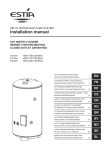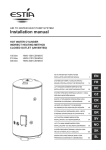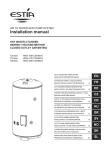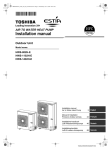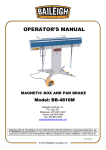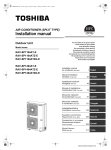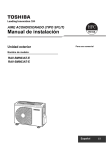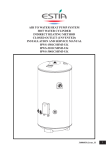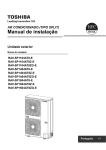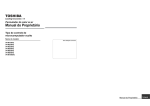Download HWS-1501-3001CSHM3-E Hot Water Cylinder Installation Manual
Transcript
AIR TO WATER HEAT PUMP SYSTEM Installation manual HOT WATER CYLINDER INDIRECT HEATING METHOD CLOSED OUTLET (UNVENTED) 150 litre 210 litre 300 litre HWS-1501CSHM3-E HWS-2101CSHM3-E HWS-3001CSHM3-E AIR TO WATER HEAT PUMP SYSTEM INSTALLATION AND SERVICE MANUAL 3 SYSTÈME DE POMPE À CHALEUR AIR-EAU MANUEL D'INSTALLATION ET DE RÉPARATION 14 INSTALLATIONS - UND WARTUNGSANLEITUNG 26 SERVISNÍ A MONTÁŽNÍ MANUÁL 38 PRIRUČNIK ZA UGRADNJU I SERVISIRANJE 49 FELSZERELÉSI ÉS SZERVIZELÉSI KÉZIKÖN 60 ΕΓΧΕΙΡΙ∆ΙΟ ΕΓΚΑΤΑΣΤΑΣΗΣ ΚΑΙ ΣΥΝΤΗΡΗΣΗΣ 72 INSTALLATIONS- OCH SERVICEMANUAL 84 INSTALLASJONS- OG VEDLIKEHOLDSHÅNDBOK 95 LUFT-WASSER-WARMERPUMPENSYSTEM SYSTÉM TEPELNÉHO ČERPADLA (VZDUCH - VODA) SUSTAV S TOPLINSKOM CRPKOM ZRAK-VODA LEVEGŐ-VÍZ HŐSZIVATTYÚ RENDSZER ΣΥΣΤΗΜΑ ΑΝΤΛΙΑΣ ΘΕΡΜΑΝΣΗΣ ΑΕΡΑ - ΝΕΡΟΥ LUFT/VATTEN-VÄRMEPUMPSSYSTEM LUFT-TIL-VANN VARMEPUMPESYSTEM SYSTÉM TEPELNÉHO ČERPADLA VZDUCH-VODA NÁVOD NA INŠTALÁCIU A OBSLUHU 106 PRIROČNIK ZA MONTAŽO IN VZDRŽEVANJE 118 SISTEM TOPLOTNE ČRPALKE ZRAK–VODA EN FR DE CZ CR HU GR SV NO SK SL AIR TO WATER HEAT PUMP SYSTEM INSTALLATION AND SERVICE MANUAL AIR TO WATER HEAT PUMP SYSTEM HOT WATER CYLINDER INDIRECT HEATING METHOD CLOSED OUTLET (UNVENTED) INSTALLATION AND SERVICE MANUAL IMPORTANT PLEASE READ AND UNDERSTAND THESE INSTRUCTIONS BEFORE INSTALLING THE WATER CYLINDER. INCORRECT INSTALLATION MAY INVALIDATE GUARANTEE. THE WATER CYLINDER MUST BE INSTALLED BY A QUALIFIED INSTALLER IN ACCORDANCE WITH LOCAL PLUMBING, BUILDING AND ELECTRICAL REGULATIONS. PLEASE LEAVE THIS MANUAL WITH THE UNIT FOR FUTURE REFERENCE. TECHNICAL SPECIFICATIONS Rated pressure Test pressure (hydraulic) Minimum recommended supply pressure Max. primary circuit working pressure Electrical rating (cylinder heater) Weight (full) 150 litre indirect 210 litre indirect 300 litre indirect EN 1.0 MPa (10 bar) 1.5 MPa (15 bar) 0.1 MPa (1 bar) 0.35 MPa (3.5 bar) 2.75kW @ 230V~ 181 kg 251 kg 360 kg COMPONENTS SUPPLIED • Water cylinder incorporating electric cylinder heater and thermal controls. • Safety Group incorporating a Pressure Relief Valve, Check (Non-return) Valve and Isolating Valve. • Compression nuts and olives. • Cylinder heater key spanner. 3 France Carrier S.A. Route de Thil BP 49 01122 Montiuel Cedex France Germany / Deutchsland Carrier GmbH & Co. KG Edisonstrasse 2 85716 Unterschleissheim Czech Republic / Česko AIRCOND, Klimaanlagen Handelsgesellshcaft m.b.H Petersgasse 45, A-8010 Graz Austria Croatia / Hrvatska AIRCOND, Klimaanlagen Handelsgesellshcaft m.b.H Petersgasse 45, A-8010 Graz Austria Austria / Österreich AIRCOND, Klimaanlagen Handelsgesellshcaft m.b.H Petersgasse 45, A-8010 Graz Austria Hungary / Magyar AIRCOND, Klimaanlagen Handelsgesellshcaft m.b.H Petersgasse 45, A-8010 Graz Austria Greece / Ελλάδα Carrier Hellas Aircondilioning S.A.- 4g Andersen street-11525 Athens Greece Sweden / Sverige Carrier AB - P.O.BOX 8946Arods Industrivag 32. S-402 73 Gothenburg Sweden Norway / Norge Carrier AB - P.O.BOX 8946Arods Industrivag 32. S-402 73 Gothenburg Sweden Slovakia / Slovensko AIRCOND, Klimaanlagen Handelsgesellshcaft m.b.H Petersgasse 45, A-8010 Graz Austria Slovenia / Slovenija AIRCOND, Klimaanlagen Handelsgesellshcaft m.b.H Petersgasse 45, A-8010 Graz Austria AIR TO WATER HEAT PUMP SYSTEM 1.0 IMPORTANT INSTALLATION POINTS 1.1 1.2 1.3 1.4 1.5 EN 2.0 INSTALLATION AND SERVICE MANUAL The unit, for use with the ESTIA air to water heat pump system, is a purpose designed unvented water cylinder. The water cylinder MUST be fitted with a Pressure Relief Valve that complies with your local Plumbing and Building Regulations. FAILURE TO PROVIDE ADEQUATE PRESSURE RELIEF WILL INVALIDATE ANY GUARANTEE AND LEAD TO A DANGEROUS INSTALLATION. Where the inlet pressure exceeds 0.6 MPa (6 bar) a Pressure Reducing Valve (set at max. 0.5 MPa (5 bar)) should be fitted to the inlet supply to the water cylinder. This MUST NOT be fitted between the Pressure Relief Valve and the water cylinder. A Check (non-return) Valve should be fitted to the inlet supply to the water cylinder. This MUST NOT be fitted between the Pressure Relief Valve and the water cylinder. This appliance is not intended for use by persons (including children) with reduced physical, sensory or mental capabilities, or lack of experience or knowledge, unless they have been given supervision or instruction concerning use of the appliance by a person responsible for their safety. Children should be supervised to ensure that they do not play with the appliance. INSTALLATION – GENERAL REQUIREMENTS 2.1 2.2 2.3 2.4 2.5 2.6 2.7 2.8 National Wiring Regulations may contain restrictions concerning the installation of these units in certain areas, eg. Bathrooms. The unit MUST be installed vertically. The unit must be positioned on a level surface. Enough space should be left around the unit for pipe connections and for access to controls and any safety valves fitted. Refer to Diagram 1 and the Dimensions Table to determine a suitable position for the water cylinder. NOTE: Ensure the floor can support the full weight of the unit (see TECHNICAL SPECIFICATIONS). DO NOT install where the unit may freeze. The mains water supply to the property will be supplying both the hot and cold water requirements simultaneously. It is recommended that the maximum water demand is assessed and the water supply checked to ensure this demand can be satisfactorily met. NOTE: a high mains water pressure will not always guarantee high flow rates. We suggest the minimum supply requirements should be 0.1 MPa (1.0 bar) pressure and 20 litres per minute flowrate. However, at these values outlet flow rates may be poor if several outlets are used simultaneously. The higher the available pressure and flow rate the better the system performance. LIMITATIONS: The water cylinder should not be used in association with any of the following: • 4 Situations where maintenance is likely to be neglected or safety devices tampered with. AIR TO WATER HEAT PUMP SYSTEM • • • INSTALLATION AND SERVICE MANUAL Water supplies that have either inadequate pressure or where the supply may be intermittent. Situations where it is not possible to safely pipe away any discharge from the safety valves. Areas where the water supply consistently contains a high proportion of solids or suspended matter unless adequate filtration can be ensured on the inlet water supply. Diagram 1 NOMINAL CAPACITY (litres) 150 210 300 A (mm) 315 315 315 B (mm) 354 354 354 C (mm) 800 1184 1474 D (mm) 1090 1474 2040 SURFACE AREA (sq.m) 0.65 0.79 0.79 HOT WATER OUTPUT AT 60ºC (litres) 102 163 254 MIXED HOT WATER OUTPUT AT 40ºC (litres) 243 329.5 476 HEAT LOSS (kWh/24h) 1.45 1.91 2.52 HEATING TIME 15ºC TO 60ºC - USING ELECTRIC 123 188 262 102 163 254 CYLINDER HEATER ONLY (mins) CAPACITY HEATED USING ELECTRIC CYLINDER HEATER ONLY (litres) 3.0 EN INSTALLATION – PLUMBING 3.1 3.2 3.3 3.4 Refer to section IMPORTANT INSTALLATION POINTS. Plumb in valves in the sequence shown in Diagram 2. Ensure the valves are installed in the correct orientation by reference to the direction of flow arrows marked on them. The water cylinder MUST be fitted with a Pressure Relief Valve that complies with your local Plumbing and Building Regulations. (Safety Group supplied). FAILURE TO PROVIDE ADEQUATE PRESSURE RELIEF WILL INVALIDATE ANY GUARANTEE AND LEAD TO A DANGEROUS INSTALLATION. Any discharge pipe connected to the Pressure Relief device must be installed in a continuously downward direction in a frost free environment. The water connections on the unit accept direct connection of 22mm outside diameter pipe; nuts and olives are supplied for this purpose. The thread on the connections is G3/4 to enable the use of G3/4 female connections to be used if required. DO NOT use zinc plated water pipes. When steel pipes are used the pipe should be insulated from the stainless steel vessel by using di-electric couplings. The sanitary water INLET is marked BLUE, the OUTLET is marked RED. Several hot outlets can be served, however, individual site demands should be considered when choosing capacity and the number of outlets to be served. It is recommended that an isolating valve is fitted on the cold water supply to the water cylinder. 5 AIR TO WATER HEAT PUMP SYSTEM 3.5 3.6 3.7 3.8 INSTALLATION AND SERVICE MANUAL A drain cock must be fitted below the water cylinder in the inlet pipework. It must be sited between the water cylinder and the Check Valve. A sanitary circuit expansion vessel may be fitted to the cold water supply as shown in Diagram 2 to prevent wastage of expanded water. The following sizes are recommended: 150 litre 12 litre vessel 210 litre 18 litre vessel 300 litre 24 litre vessel A re-circulation circuit can be installed on the sanitary water circuit. A connection is provided for the re-circulation circuit return pipe (threaded G3/4 female). The primary heating circuit MUST be connected via the Hydro Unit. Refer to the Installation Instructions supplied with the Hydro Unit for full details. Diagram 2 4 8 1 3 9 2 1 EN 5 6 COLD WATER INLET 2 ISOLATING VALVE 3 SAFETY GROUP NF7 BAR 4 SANITARY WATER EXPANSION VESSEL 5 DISCHARGE PIPE 6 PRIMARY CIRCUIT RETURN 7 PRIMARY CIRCUIT FLOW 8 HOT WATER OUTLET 9 SANITARY WATER RE-CIRCULATION CONNECTION 7 4.0 ELECTRICAL REQUIREMENTS 4.1 4.2 4.3 4.4 4.5 4.6 6 1 The unit is supplied with a factory fitted cylinder heater complete with thermal sensor and over-temperature cut-out. The cylinder heater is rated 2.75kW at 230V~. The cylinder heater is located behind the white terminal cover on the front of the unit. The cover is secured by 2 screws on each side of the cover and a threaded domed nut on the front of the cover. ISOLATE THE ELECTRICAL SUPPLY BEFORE REMOVING THE COVER. The cylinder heater MUST be earthed. All electrical wiring should be carried out by a competent electrician and be in accordance with the latest national Wiring Regulations. The circuit must be protected by a suitable fuse and double pole isolating switch with a contact separation of at least 3mm in both poles. The cylinder heater should be wired in accordance with Diagram 3 and the Air to Water Heat Pump Installation Manual. The supply cable must be via the Heat Pump Controls Housing, direct connection to the mains electrical supply will invalidate the guarantee and may result in a dangerous installation. The supply cable must be routed through the right hand cable gland provided and the outer sheath of the cable firmly secured by tightening the screw on the cable gland. The recommended cable type is 2.5mm2 3 core heat resistant sheathed. The thermal sensor should be connected to the Heat Pump Controls Housing in accordance with Diagram 3 and the Air to Water Heat Pump Installation Manual. AIR TO WATER HEAT PUMP SYSTEM 4.7 4.8 4.9 INSTALLATION AND SERVICE MANUAL The cable to the thermal sensor must be routed through the left hand cable gland provided and the outer sheath of the cable firmly secured by tightening the screw on the cable gland. The sensor cable should be 0.75mm2 2 core + shield (ground) with a maximum current rating of 100mA. The cable should not be longer than 5 metres. Replace the terminal cover before operating. DO NOT heat the unit until the water cylinder has been completely filled with water. Thermal control of the water cylinder is done by the Hydro Unit controls. Refer to the Air to Water Heat Pump Installation Manual for instructions for setting the hot water storage temperature. 4.10 The electrical supply from the Air to Water Heat Pump to the cylinder heater incorporates an over-temperature thermal cut-out that will switch off the cylinder heater in the event of a thermal control failure. DO NOT bypass the thermal cut-out in any circumstances. Diagram 3 5 4 4 3 6 6 1 2 2 TBO3 (230V) 3 A B 1 TO HYDRO UNIT 2 SENSOR 3 GREEN/YELLOW 4 BLUE 5 DOUBLE POLE THERMAL CUT-OUT 6 BROWN 7 230V~ MAINS SUPPLY FROM HYDRO UNIT. 1.5mm2 MIN. CABLE SIZE TBO6 (TTW) 1 5.0 7 EN COMMISSIONING WARNING: Water that is left standing in a stainless steel water cylinder for long periods without draw off will become de-oxygenated and potentially corrode the vessel material. If the installation is to be left unused following installation and commissioning the water cylinder should be drained or regularly (once per week) flushed through with fresh mains water. When placing the unit into service the procedure for filling the unit and the system checks detailed below should be repeated. 5.1 5.2 5.3 5.4 5.5 5.6 5.7 DO NOT switch on the Air to Water Heat Pump until the unit has been filled with water and checked for leaks. Check that all installation, electrical and discharge pipe requirements have been met. Check that all water and electrical connections are correctly made and are tight. Open a hot tap supplied by the unit, turn on the cold water supply to the unit. Allow the unit to fill and leave the hot tap running for a short while to purge any air and flush out the pipework. Close the hot tap. Open successive hot taps to purge any air from the system. With all hot taps closed, check the system for water leaks and rectify as necessary. 7 AIR TO WATER HEAT PUMP SYSTEM 5.8 5.9 INSTALLATION AND SERVICE MANUAL Manually test the operation of the Pressure Relief Valve. Ensure water flows freely from the valve and through the discharge pipe. Fill the primary circuit following the “Water Pipe” section in the Hydro Unit Installation Manual. Vent any trapped air by opening the air bleed point or automatic air vent. 5.10 Switch on the electrical supply to the Air to Water Heat Pump and ensure the programmer is set to HOT WATER mode. Check that any motorised valves or primary pumps are working and allow the unit to heat. The hot water temperature may be varied using the Hydro Unit remote controller, for details refer to the Air to Water Heat Pump Owners Manual. 6.0 MAINTENANCE – DESCALING CYLINDER HEATER 6.1 6.2 EN 6.3 6.4 6.5 6.6 6.7 6.8 6.9 Little maintenance is required, however in hard water areas the unit will require periodic descaling to ensure efficient operation. To descale the unit: Switch off and disconnect the electrical supply and shut down the heat pump. Turn off the water supply to the unit. Open a hot tap served by the unit to relieve any system pressure. Empty the unit by opening the drain valve in the inlet pipework. Open the terminal cover. Carefully remove the thermal sensor from its pocket on the cylinder heater by pulling outwards. Disconnect the link wires connecting the thermal cut-out to the cylinder heater. Carefully remove the thermal cut-out sensing bulb from its pocket on the cylinder heater by pulling outwards. Be careful not to kink the capillary tube. Remove the element tail insulating shroud by pulling it outwards from the element. Unscrew cylinder heater backnut. A key spanner is provided with the unit for easy removal/tightening of the cylinder heater backnut. Remove the cylinder heater from the unit. NOTE over time the cylinder heater gasket may become stuck to the mating surface, to break the seal insert a round bladed screwdriver into one of the pockets on the cylinder heater and gently lever up and down. Carefully remove any scale from the surface of the element. DO NOT use a sharp implement as damage to the element surface could be caused. Ensure sealing surfaces are clean and seals are undamaged. If in doubt fit a new gasket. 6.10 Replace cylinder heater ensuring the element tails are in the VERTICAL plane (see Diagram 3). Secure in place by re-fitting cylinder heater backnut and tightening. It may be helpful to support the cylinder heater using a round bladed screwdriver inserted into one of the element pockets whilst the backnut is being tightened. 6.11 Replace the element tail insulating shroud by carefully pushing over the element tails until it sits flush with the face of the element mounting plate. 8 6.12 Replace the thermal cut-out capillary in the LEFT HAND pocket of the cylinder heater. Ensure it is fully inserted and that the capillary tube is not kinked. Ensure the capillary tube is routed such that it does not come into contact with the element tails. AIR TO WATER HEAT PUMP SYSTEM INSTALLATION AND SERVICE MANUAL 6.13 Replace the thermal sensor into the LEFT HAND pocket of the cylinder heater behind the thermal cut-out. Ensure it is fully inserted, and the securing grommet is pushed into the open end of the pocket. 6.14 Refit the cylinder heater wiring links by inserting the male terminations into the female terminals on the element tails in accordance with Diagram 3. Check all wiring terminations are tight and secure. Replace and secure the terminal cover. 6.15 DO NOT SWITCH ON EITHER THE AIR TO WATER HEAT PUMP OR CYLINDER HEATER UNTIL THE UNIT HAS BEEN RE-FILLED WITH WATER. Re-commission the unit following the Installation and COMMISSIONING instructions. Diagram 4 5 1 2 3 4 7.0 TERMINAL BRACKET 2 THERMAL CUT-OUT 3 SENSOR TERMINAL BLOCK 4 MAINS TERMINAL BLOCK 5 RESET BUTTON LOCATED ON THIS FACE NOTE: THE COVER AND ELEMENT ASSEMBLY HAVE BEEN REMOVED FROM THIS VIEW FOR CLARITY MAINTENANCE – SAFETY VALVES 7.1 7.2 8.0 1 The Pressure Relief Valve and any other safety valves fitted should be regularly checked for correct operation. EN Manually operate the valve(s) and ensure that water flows freely from the valve and through the discharge pipe. NOTE: the water discharged may be very hot. Ensure the valve re-seats correctly when released. USER INSTRUCTIONS 8.1 8.2 8.3 The water storage temperature at the Air to Water Heat Pump System Water Cylinder is set at the control panel of the Hydro Unit. This can be set to give temperatures in the range of 40ºC to 75ºC, 60ºC is recommended. Refer to the Hydro Unit Installation Manual for details of how to adjust the storage temperature should this be necessary. To avoid any risk of freezing when the cylinder is not in use for long periods during the winter months, it is recommended that the Air to Water Heat Pump primary supply and the cylinder heater are switched off and the water cylinder is drained. NOTE: this will not protect other parts of the system pipework. If this is done the water cylinder must be fully re-commissioned prior to switching on the Air to Water Heat Pump and cylinder heater or damage may be caused. To ensure the water cylinder continues to operate at its optimum performance it should periodically be maintained in accordance with the instructions given under the sections headed MAINTENANCE. 9 AIR TO WATER HEAT PUMP SYSTEM 8.4 INSTALLATION AND SERVICE MANUAL IMPORTANT NOTES TO THE USER • Do not block or restrict the discharge from any safety valve fitted. • Do not bypass the thermal cut-out in any circumstances. • Do not tamper with any safety valve fitted. • 9.0 If a fault is suspected contact a qualified engineer to check the system. SPARE PARTS 9.1 9.2 9.3 The following list of spare parts is available for the Air to Water Heat Pump water cylinder. Refer to the technical data label on the unit to identify the model installed and to ensure the correct parts are ordered. DO NOT replace with parts not recommended by the manufacturer as this will invalidate your guarantee and may render the installation dangerous. 1 2 EN 3 5 6 7 8 9 12 Description Part No. Cylinder heater ................................................................................95:606:967 Cylinder heater gasket.....................................................................95:611:012 Cylinder heater backnut...................................................................95:607:118 Cylinder heater key spanner............................................................95:607:119 Thermal cut-out (cylinder heater) ....................................................95:612:038 Element tail insulating shroud..........................................................95:607:115 Terminal cover .................................................................................95:614:109 Terminal block (cylinder heater connection)....................................95:607:113 Terminal block (thermal sensor connection)....................................95:607:114 Thermal sensor................................................................................95:612:037 Set of compression nuts and olives.................................................95:607:116 Secondary re-circulation connection plug .......................................95:607:117 Safety Group ...................................................................................95:605:073 Diagram 5 12 10 5 1 2 6 9 3 8 7 AIR TO WATER HEAT PUMP SYSTEM 10.0 INSTALLATION AND SERVICE MANUAL FAULT FINDING The table below lists some common faults, their possible causes and their remedy. Any servicing of the water cylinder and Air to Water Heat Pump system must be carried out by a trained competent installer. FAULT No hot water flow Water from hot taps is cold Water from hot taps is only warm Water from hot taps is too hot Water discharges from Pressure Relief Valve continually POSSIBLE CAUSE REMEDY 2. Mains water filter (if fitted) blocked 2. Turn off water supply. Remove filter and clean in accordance with manufacturers instructions 1. Mains water supply off 3. Inlet water control valves incorrectly fitted 1. Check and turn on mains water supply 3. Check and refit as required 1. Controller on Heat Pump Hydro Unit set to Space Heating only 1. Check setting 3. Faulty water cylinder temperature sensor 3. Check sensor operation. Replace if necessary 2. Heat Pump not working 1. Cylinder heater thermal cut-out has operated 2. Faulty water cylinder temperature sensor 1. Water storage temperature on Heat Pump Controller is set too high 2. Check operation of Heat Pump. If a fault is suspected consult the Heat Pump Manual 1. Check. Reset by pushing button on cut-out 2. Check sensor operation. Replace if necessary 1. Check and adjust as required 2. Faulty water cylinder temperature sensor 2. Check sensor operation. Replace if necessary 2. Pressure Relief Valve seat is damaged 2. Remove and replace 1. Mains water pressure too high EN 1. Refer to section Important Installation Points for correct pressure. If necessary fit a Pressure Reducing Valve to inlet water supply 11 AIR TO WATER HEAT PUMP SYSTEM 11.0 INSTALLATION AND SERVICE MANUAL GUARANTEE For warranty details please contact your ESTIA Heat Pump supplier. This water cylinder is guaranteed provided that: 11.1 The unit has been installed in accordance with these instructions and all necessary inlet controls and safety valves have been fitted correctly. 11.2 Any valves or controls are of the manufacturers recommended type. 11.3 The unit has not been tampered with and has been regularly maintained as detailed in these instructions. 11.4 The unit has been used only for heating potable water (max. 250mg/l chloride). 11.5 The unit has not been subjected to high chloride levels in the water supply or incorrect disinfection methods. 11.6 Following commissioning the unit is put into service within a period of 7 days. If this is not the case it must either be drained or regularly flushed as required in the section “Commissioning – Warning”. 11.7 The unit is NOT guaranteed against damage by frost or due to build up of scale. EN 11.8 This guarantee does not affect the statutory rights of the consumer. This guarantee DOES NOT cover the ESTIA Air to Water Heat Pump Outdoor Unit or ESTIA Hydro Unit. 12.0 ENVIRONMENTAL INFORMATION 12.1 This product is manufactured from many recyclable materials. At the end of its useful life it should be disposed of at a Local Authority Recycling Centre to realise the full environmental benefits. 12.2 The insulation material is CFC/HCFC free expanded polyurethane foam with an ozone depletion factor of zero. The pace of product development is such that we reserve the right to change product specifications without notice. We do, however, strive to ensure that all information in this leaflet is accurate at the time of publication. 12 AIR TO WATER HEAT PUMP SYSTEM INSTALLATION AND SERVICE MANUAL IMPORTANT INFORMATION AND WARNING READ BEFORE INSTALLING THE UNIT. KEEP IN A SAFE PLACE. THE INFORMATION IN THE FOLLOWING NOTES IS NEEDED FOR THE END OF LIFE DISPOSAL OR REUSE OF THE UNIT. • • • • • • • • • • • We are very sensitive to the environment and welcome the 2002/96/EC WEEE (Waste Electrical and Electronic Equipment) Directive. This product is compliant with EU Directive 2002/96/EC. It must be collected separately after its use is completed and must not be disposed of as unsorted municipal waste. The objectives of the EU Directive 2002/96/EC are to tackle the fast increasing waste stream of electrical and electronic equipment, increase the recycling of electric and electronic equipment (“EEE”), and to limit the total quantity of waste EEE (“WEEE”) going to disposal. The crossed out wheeled bin symbol that is affixed to the product indicates that this product may fall under the Directive. The user is responsible for returning the product to the appropriate collection facility as specified by your municipality or the distributor. In case of installation of a new product, it may be possible to have the distributor pick up old WEEE directly. The producer, importer and distributor are responsible for collection and treatment of WEEE, either directly or through a collective system. The distributor for your country is shown below. In case of violation of the Directive, sanctions are set in each country. EN We are in general following the CECED interpretation which considers the WEEE Directive applicable to Portable units, De-humidifiers, WRACs (Window Room Air to Water Heat Pumps), Split systems up to 12kW, plug in refrigerators and freezers. Nevertheless, there may be differences among various member state laws. In cases where national laws exclude some products from the WEEE scope, those laws must be followed. In countries where these products are not covered by the WEEE scope the WEEE obligations do not have to be followed. The WEEE Directive does not apply to products sold outside the European Community. In these cases the WEEE obligations do not have to be followed, however compliance with any local regulations must be ensured. For additional information please contact the municipal facility, the shop/dealer/distributor/installer that has sold the product, or the producer. 13 NOTES 129 NOTES 130















